Use of Rome, with numerous other devotional texts, in Latin and French, illuminated manuscript on parchment [Southern Netherlands (Bruges), c.1460] 313 leaves (including 9 leaves added at end in sixteenth century, and plus two paper endleaves at front and back), too tightly bound too collate, but wanting approximately 7 text leaves (see below), single column, 18 lines in two sizes of a fine and regular Burgundian lettre bâtarde with ornamental penwork cadels, red rubrics, Calendar leaves (24 in total) in gold, blue and red, with every leaf in this part of text opening with a 3-line initial ‘KL’ in blue or pink with foliate infill on bright gold grounds and a single decorated border panel of single-line foliage ending in coloured flowerheads and gold bezants, every line of Calendar beginning with a gold initial on burgundy and blue grounds, main text with same initials (often several per page) from one to 4-lines in height, the larger accompanied by single border panels (approximately 250 of these), eleven leaves with similar borders which extend down outer edge and halfway across top and bottom margins, thirteen leaves with 5-line illuminated initials with full-borders of acanthus leaves and other foliage (including realistic studies of sprigs of hazelnuts) enclosing drolleries, animals, birds and a bear and a monkey playing chess, thirty-eight historiated initials enclosing portraits of saints by a follower of William Vrelant, initial on fol.47v smudged, slight wear and thumbing to edges in places, occasional offsetting, sections of borders of fols.122 and 305 cut away, remnants of sale ticket once pasted to front endleaf, marks showing original leaves at each end once pastedowns in earlier binding, else in bright and sparkling condition on excellent parchment with wide and clean margins, 175mm. by 121mm., seventeenth-century French mottled calf with floral gilt spine in six compartments, spine restored, marbled endleaves, in fleece-lined brown morocco box with gilt title by the Lakeside Press, Chicago Provenance: (1) Almost certainly written and illuminated in Bruges for a married couple who were close to the family of the Burgundian dukes: with prayers in both masculine and feminine forms, and in some cases asking for blessings for “famulos tuos” and “servos tuos” (‘your servants’, fols.254r-255v). The Bruges saint, Basil (who had a chapel dedicated to him on the central square in the city, which abutted up against the ancestral comital residence) is highlighted in gold on 3 April in the Calendar, and there are other local saints, such as Omer, Bertin, and Bavo in the Litany. The presence of SS. Iodocus or Josse (after whom Philip the Good named his second son, the boy sadly dying only days after birth in 1432) and Louis (patron of the French royal family and their descendants) points towards the Burgundian court, and this impression is confirmed by the inclusion of Anselm’s meditation on chastity on fols.268r-76r and a series of the saints commemorated in the last part of the book. Anselm’s text also appears in the prayer book of Philip the Bold, the first Valois duke of Burgundy (Brussels, Bibl. Royale MS.10392), and among the saints here are Adrian, Gregory, Claud, Bernadino (canonised in 1450), Anne and Barbara, who were added to Philip the Bold’s book when it was later enlarged for the personal use of his grandson, Philip the Good (see S. Panayotova and N. Morgan, A Catalogue of Western Book Illumination in the Fitzwilliam Museum and Cambridge Colleges, I, 2009, for Fitzwilliam, MS 3-1954). There are no arms or heraldic devices in the book, and it would appear that the original owners were trusted (but perhaps not noble) servants of the Burgundian court. It may even have been a commission by a member of the ducal household for these recipients. (2) Within a few decades, the volume would appear to have been in the hands of an owner from the house of Luxembourg (whose title passed to the Burgundian dukes in 1467), and it
Use of Rome, with numerous other devotional texts, in Latin and French, illuminated manuscript on parchment [Southern Netherlands (Bruges), c.1460] 313 leaves (including 9 leaves added at end in sixteenth century, and plus two paper endleaves at front and back), too tightly bound too collate, but wanting approximately 7 text leaves (see below), single column, 18 lines in two sizes of a fine and regular Burgundian lettre bâtarde with ornamental penwork cadels, red rubrics, Calendar leaves (24 in total) in gold, blue and red, with every leaf in this part of text opening with a 3-line initial ‘KL’ in blue or pink with foliate infill on bright gold grounds and a single decorated border panel of single-line foliage ending in coloured flowerheads and gold bezants, every line of Calendar beginning with a gold initial on burgundy and blue grounds, main text with same initials (often several per page) from one to 4-lines in height, the larger accompanied by single border panels (approximately 250 of these), eleven leaves with similar borders which extend down outer edge and halfway across top and bottom margins, thirteen leaves with 5-line illuminated initials with full-borders of acanthus leaves and other foliage (including realistic studies of sprigs of hazelnuts) enclosing drolleries, animals, birds and a bear and a monkey playing chess, thirty-eight historiated initials enclosing portraits of saints by a follower of William Vrelant, initial on fol.47v smudged, slight wear and thumbing to edges in places, occasional offsetting, sections of borders of fols.122 and 305 cut away, remnants of sale ticket once pasted to front endleaf, marks showing original leaves at each end once pastedowns in earlier binding, else in bright and sparkling condition on excellent parchment with wide and clean margins, 175mm. by 121mm., seventeenth-century French mottled calf with floral gilt spine in six compartments, spine restored, marbled endleaves, in fleece-lined brown morocco box with gilt title by the Lakeside Press, Chicago Provenance: (1) Almost certainly written and illuminated in Bruges for a married couple who were close to the family of the Burgundian dukes: with prayers in both masculine and feminine forms, and in some cases asking for blessings for “famulos tuos” and “servos tuos” (‘your servants’, fols.254r-255v). The Bruges saint, Basil (who had a chapel dedicated to him on the central square in the city, which abutted up against the ancestral comital residence) is highlighted in gold on 3 April in the Calendar, and there are other local saints, such as Omer, Bertin, and Bavo in the Litany. The presence of SS. Iodocus or Josse (after whom Philip the Good named his second son, the boy sadly dying only days after birth in 1432) and Louis (patron of the French royal family and their descendants) points towards the Burgundian court, and this impression is confirmed by the inclusion of Anselm’s meditation on chastity on fols.268r-76r and a series of the saints commemorated in the last part of the book. Anselm’s text also appears in the prayer book of Philip the Bold, the first Valois duke of Burgundy (Brussels, Bibl. Royale MS.10392), and among the saints here are Adrian, Gregory, Claud, Bernadino (canonised in 1450), Anne and Barbara, who were added to Philip the Bold’s book when it was later enlarged for the personal use of his grandson, Philip the Good (see S. Panayotova and N. Morgan, A Catalogue of Western Book Illumination in the Fitzwilliam Museum and Cambridge Colleges, I, 2009, for Fitzwilliam, MS 3-1954). There are no arms or heraldic devices in the book, and it would appear that the original owners were trusted (but perhaps not noble) servants of the Burgundian court. It may even have been a commission by a member of the ducal household for these recipients. (2) Within a few decades, the volume would appear to have been in the hands of an owner from the house of Luxembourg (whose title passed to the Burgundian dukes in 1467), and it
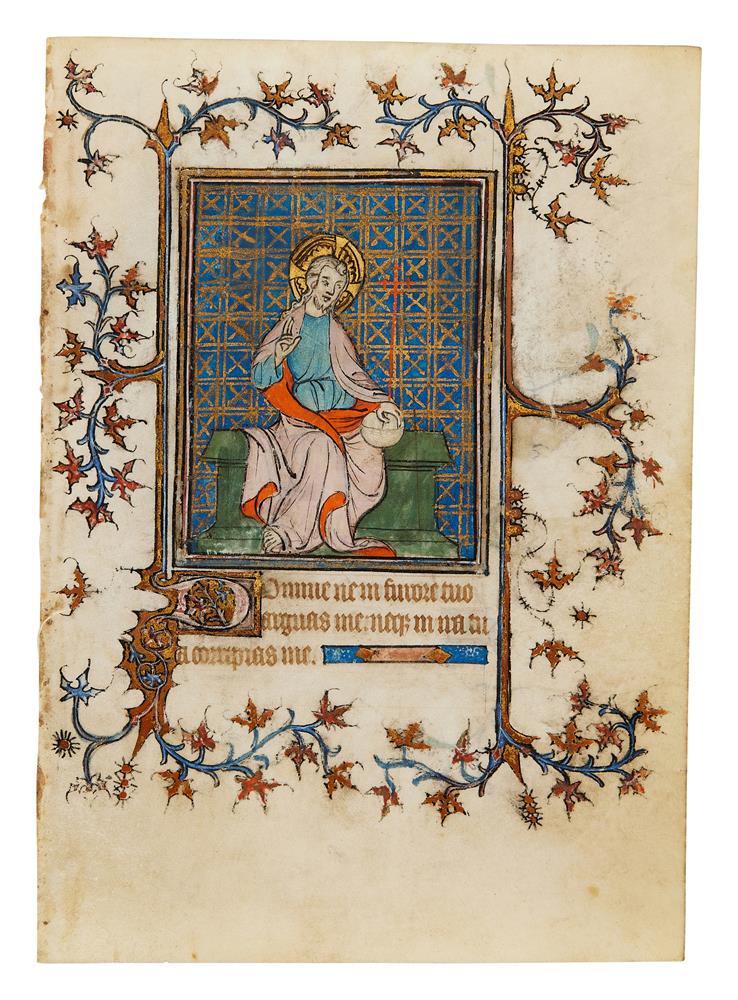
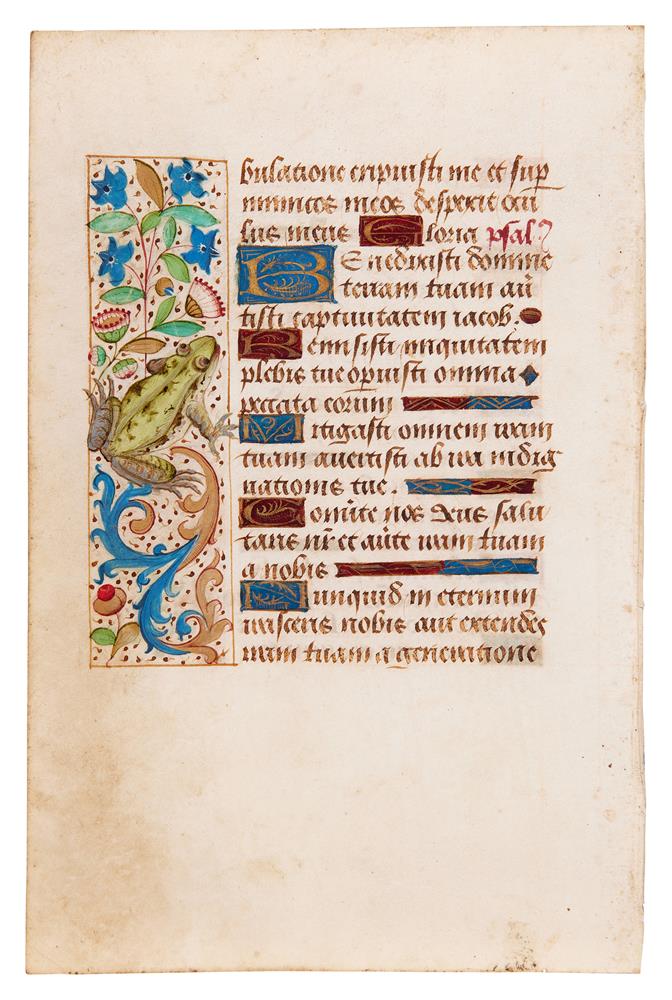
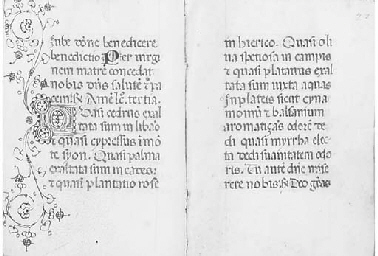
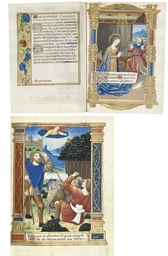





.jpg)

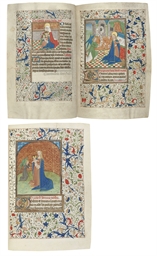
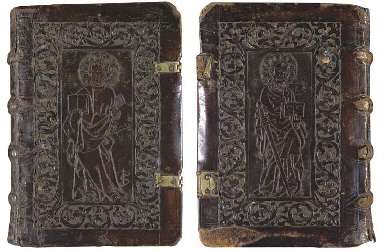

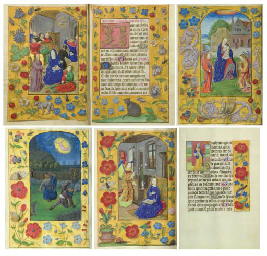
Testen Sie LotSearch und seine Premium-Features 7 Tage - ohne Kosten!
Lassen Sie sich automatisch über neue Objekte in kommenden Auktionen benachrichtigen.
Suchauftrag anlegen